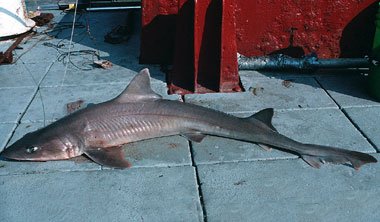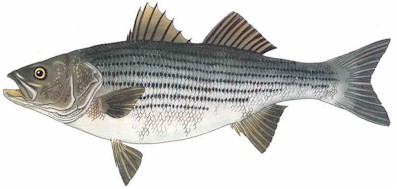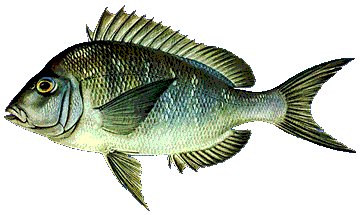Sandbar (Brown) Shark
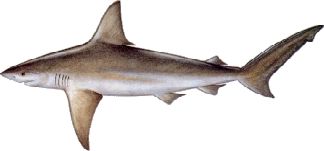
Carcharhinus plumbeus
Size:
to 6 ft
The Sandbar Shark is the commonest inshore shark in New Jersey waters.
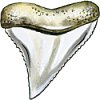
Most people are familiar with Peter Benchley's thrilling novel Jaws or one of the movies it has inspired. The image of a giant shark terrorizing a small resort community is hard to forget. After all, the idea of predators ( in this case, people ) becoming prey realizes one of our most primal fears. It also makes for exciting reading or viewing.
By Al Ivany
Fortunately, actual shark attacks are rare. In fact, few species of shark are considered dangerous to man and the poor reputation sharks have earned throughout much of history is horn more out of fear and ignorance than scientific fact. New Jersey's coastal waters harbor a rich diversity of marine life. Included in this diversity are several species of shark, one of which is the Sandbar Shark.
The Sandbar Shark ( Carcharinus plurnbeus ) - also commonly known as the Brown Shark - is a small-to-medium-sized shark found in temperate and tropical waters worldwide. It is a heavy-bodied shark with a large dorsal fin, the vertical height of which exceeds 10 percent of its total body length. Its coloration is dark gray to brown above, becoming almost whitish below. Length at birth is approximately 25 inches, while mature adults average six feet. In New Jersey, a similar shark, the dusky, may be confused with the sandbar shark. But the dusky has a smaller dorsal fin and is significantly larger at maturity.

Estuaries, bays, and coastal areas are the preferred habitats of the sandbar shark, which is the most commonly seen toothed shark in our coastal bays. The sharks are bottom dwellers found predominately at depths of 10 to 30 fathoms, but occasionally at depths of more than 100 fathoms. Because they are bottom dwellers and stay away from beaches, the sandbar shark has rarely - if ever - been implicated in an attack on a human.
Sandbar sharks are highly migratory, ranging in North America from New England to Florida and the Gulf of Mexico. In New Jersey, the sharks occur in highest concentrations during the summer months when they migrate north to their primary nursery grounds. Recently, one tagged specimen was recovered and found to have traveled 2,019 miles from Point Judith, Rhode Island, to Mexico. This is the third longest migration reported for a sandbar shark.
Like many predators, sandbar sharks are opportunistic feeders. Their diet is varied, consisting mainly of small fish, crustaceans, mollusks, and, in some places, octopuses. While sandbar sharks have large mouths, their teeth are relatively small and this makes it unlikely that they can attack anything larger than the prey on which they feed.
The abundance of sandbar sharks is testimony to their reproductive success. The sharks mate in spring and early summer. After a gestation period of nine to 12 months, pregnant females move to nursery grounds in shallow waters close to shore and give birth to an average of nine pups ( anywhere from one to 14 pups is possible. ) the newborn sharks resemble scaled-down versions of the adults and are on their own to fend for themselves as soon as they are born. At this young age, the sharks' mortality rates are high as larger predators such as tiger and bull sharks feed upon them. The young sharks will stay in shallow waters until cooler temperatures set in. They then move to deeper waters, possibly forming schools.
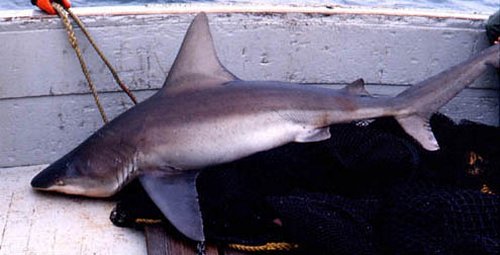
Because sandbar sharks are born alive and are large at birth, their survival rates are high - much greater than that of egg-laying fishes. In fact, a large fishing industry has developed for them and they are considered one of the most economically important species on the East Coast. Though it is not currently heavily fished in New Jersey, elsewhere both recreational and commercial anglers seek out the shark's palatable meat. In fact, it is reported to be the most abundant commercially valuable shark taken off the southeastern coast of Florida.
Despite their high survival rates, sandbar shark populations are still susceptible to overfishing. This results from the fact that they grow very slowly ( only about two inches a year, ) mature at an old age, and bear relatively few young. In fact, sandbar sharks were recently included along with 21 other species of large coastal sharks - in a new management effort by the National Marine Fisheries Service that for the first time sets commercial quotas and sportfishing bag limits for sharks.
If we are conscious of our actions and sensible in our management, the sandbar shark will always be a part of New Jersey's natural heritage. As both predator and prey, the shark fills a critical niche in the marine ecosystem and in the lives of those who depend on it for their livelihoods. And, unlike the situation portrayed in Jaws, this species - and the overwhelming majority of sharks - has much more to fear from humans than the other way around.
Al Ivany is a naturalist and media specialist with the Division of Fish, Game and Wildlife's Pequest Natural Resource Education Center in Oxford
This article first appeared in New Jersey Outdoors - Summer 1993

